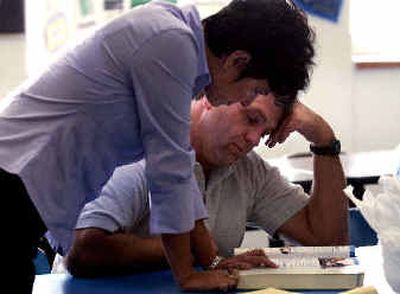A team approach to teaching, learning

By this time last year, East Valley High School administrators had already dealt with 43 discipline problems among freshman students.
This year, the school has dealt with half that many.
“You can really feel and see a difference in the climate of the school,” said Mark Purvine, assistant principal for academics and curriculum.
The difference is not in the students. It’s in the way they are learning each day, Purvine said.
Starting this year, East Valley’s freshmen are grouped into 90-student teams for English, science, social studies and career exploration for part of the day. About 30 students in each team spend most of their time together for three periods each day, so they become particularly close with their teachers and their peers.
The concept is part of an effort to create smaller learning communities at the high school level, as defined by the federal No Child Left Behind Act.
“This can be a scary place for freshman new to the environment,” Purvine said. “Ninth grade is by far the most problematic year for most students. More dropouts happen in this year than any other.”
According to the U.S. Department of Education, studies indicate that the size of a learning environment has an indirect effect on student learning. Students in smaller learning groups experience a greater sense of belonging, and are more successful. Some indicators include a decrease in discipline problems and dropout rates, increased graduation rates and an increase in the number of students who go on to college.
The concept of developing small learning communities is not new to the Spokane area.
West Valley began breaking up its ninth-grade students into teams in the fall of 2002.
Shadle Park and Rogers high schools split up their freshman classes last fall, said Emmett Arndt, executive director of teaching and learning for Spokane Public Schools. This year, Rogers created small learning communities made up of all students, not just freshmen, Arndt said.
Both schools are using federal grants to create smaller groups.
East Valley started planning for the concept two years ago, in order to prepare the class of 2008 for the Washington Assessment of Student Learning, which the students must pass in order to graduate. The WASL is connected to the federal act, which set the goal of having every child proficient in reading and math by 2014.
“It really was the driver behind all of this,” Purvine said. “But we had to do something for these kids. There wasn’t any more time to think about, plan for it.”
The staff developed a schedule for the teams, teaching the students in two blocks – morning and afternoon. The teachers share the same set of students for the core courses, and the other half of the day is used for math and elective courses.
Teachers also share a preparation period, during which they discuss their lesson plans, collaborate on projects, and identify poor and above-level performing students together.
“It’s refreshing as a teacher because we get some different ideas from different subject areas that we normally wouldn’t” said science teacher Rob Collins. “It’s helped me to be more organized.”
Currently, the teachers are trying to put together a project on forensics. Students in career exploration classes would get to meet with professionals, students in English would create a mystery in literature form, and students in science would learn about the scientific methods for solving a crime. In social studies, teachers could use anthropology curriculum to talk about human remains.
“We feel really challenged as teachers,” said English teacher Tammy Hovren. “It’s more work, but it’s more rewarding.”
The only criticism for the concept came from parents who worried that their freshmen would no longer be offered honors classes under the new schedule. Instead of offering one or two homogenous English honors courses to freshman, the school is offering honors-level work to all interested students within the team courses.
Purvine said team teaching increased the number of students able to take honors options. Eighty-seven students are signed up for honors options this year, compared to 51 last year, and honors options are offered in more subject areas than just English.
“Before there were some students recommended for honors that the school was unable to serve because of class-size limits,” Purvine said. “We had some students who were just left out. Now we are able to challenge any student who wants to be.”